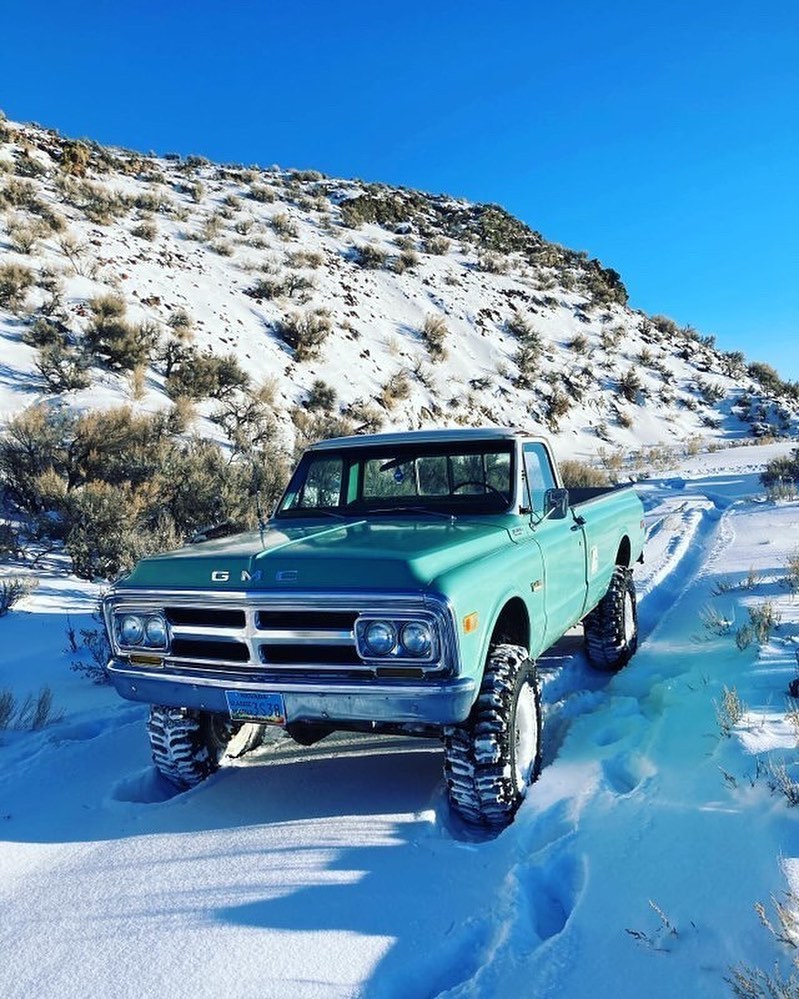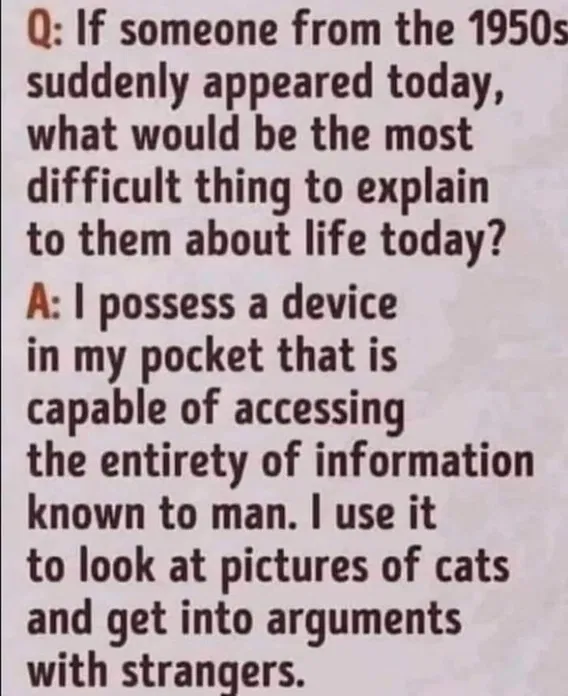Join the Hide community
Get access to live stream, lessons, the post exchange, and chat with other snipers.
Register
Download Gravity Ballistics
Get help to accurately calculate and scope your sniper rifle using real shooting data.

Install the app
How to install the app on iOS
Follow along with the video below to see how to install our site as a web app on your home screen.
Note: This feature may not be available in some browsers.
You are using an out of date browser. It may not display this or other websites correctly.
You should upgrade or use an alternative browser.
You should upgrade or use an alternative browser.
Maggie’s Funny & awesome pics, vids and memes thread (work safe, no nudity)
- Thread starter Lawless
- Start date
I wish I had that, when I started we programmed the Honeywell controls with boxes of punch cards stored in a filing cabinet next to the EWS. We eventually got a disk reader added, the floppies were about the size of a vinyl album
Q
Office at the college. We’ve grown old together, and gone from punchcards to AI.
When I met my wife she was carrying a box full of punch cards. Cutest little office girl I ever met. She worked for the VetsI wish I had that, when I started we programmed the Honeywell controls with boxes of punch cards stored in a filing cabinet next to the EWS. We eventually got a disk reader added, the floppies were about the size of a vinyl album
Office at the college. We’ve grown old together, and gone from punchcards to AI.
A couple of years ago my dad brought home a hard drive from work that needed to be destroyed. He doesn't remember the capacity but said that it came from a DAC computer at a chemical plant. It was a good 4 or 5 inches tall and a very small capacity. I remember looking it up at the time and I think it was $3,000+ back in the day. Brain wants to remember $13000 but I think that is off.When I was very young my Dad's work had 8" disks and a magnet hard drive.
The subject falls into the "Awesome" category.
The subject falls into the "Awesome" category.
The Fat Electrician is one of my favorite youtubers.
Whipper snappers
Was I the only one who punched a hole on the other side so that I could make them double sided disks to double the storage?
Yes... because I'm not admitting to being THAT old.Was I the only one who punched a hole on the other side so that I could make them double sided disks to double the storage?
The Fat Electrician is one of my favorite youtubers.
History from a guy that talks like me, Sirh if he was a much younger fella.
anybody know what kind of fish this is?

Not mine, but many moons ago I worked at a place which had these. They were mothballed as "modern" computer's were alive and thriving, but they certainly had them in one of the offices and one old machine which ran on tapes.
View attachment 8622781
View attachment 8622782
Not mine, but many moons ago I worked at a place which had these. They were mothballed as "modern" computer's were alive and thriving, but they certainly had them in one of the offices and one old machine which ran on tapes.
Cut my teeth on one like it in college and used one at one of my jobs as well.
Figured out how to send print jobs to one in college so I was able to develop/test from a terminal and still turn in cards for the assignment.
ETA: Just realized I used the word "terminal" ... does that even mean anything to younger nerds anymore?

Last edited:
View attachment 8622781
View attachment 8622782
Not mine, but many moons ago I worked at a place which had these. They were mothballed as "modern" computer's were alive and thriving, but they certainly had them in one of the offices and one old machine which ran on tapes.
Just seeing one of those annoys the crap out of me… it’s like I have PTSD…
(we used a version of those for coding and decoding back in the day.)
View attachment 8622781
View attachment 8622782
Not mine, but many moons ago I worked at a place which had these. They were mothballed as "modern" computer's were alive and thriving, but they certainly had them in one of the offices and one old machine which ran on tapes.
Also, you forgot about this….
I have used the following computers back in the day…











The first computer I worked with used punch cards that were stack loaded to program the magnetic core memory.
Just think; people pay money for this!
Who learned on an abacus?
P
Okinawa, early 80s. I saw couple of shopkeepers use an abacus. They were faster than me with a calculator.
I didnt show this because of the valor of the Athenians, though they certainly deserve it, but rather for the name of the burial mound in the secondline/second paragraph. Seems fitting.
Imagine standing on the very ground where 192 Athenian warriors made their final stand against the Persian Empire in 490 BC. The Battle of Marathon, fought on the plains of Marathon, Greece, is a pivotal moment in history, symbolizing the resilience and valor of the ancient Greeks.
In the aftermath of this remarkable victory, the Athenians honored their fallen soldiers by constructing a large burial mound, known as a "tumulus" or "Soros," on the battlefield. This monumental structure, approximately 30 feet high and 164 feet wide, was not only a physical tribute but also a symbol of Athenian unity and bravery. Unlike the typical Athenian practice of burying war dead in the Kerameikos cemetery in Athens, the decision to inter the 192 fallen warriors at Marathon was a deliberate act to commemorate their heroism on the very site of their sacrifice.
Excavations of the mound have revealed significant archaeological findings. In 1884, archaeologist Dimitrios Philios uncovered a large layer of ash and charred bones within the mound, confirming that the Athenians had cremated their dead—a practice consistent with ancient Greek funerary customs. Further excavations in 1890 and 1891 by Valerios Stais, and later in 1970 by Spyridon Marinatos, unearthed additional remains and artifacts, including pottery and oil phials, providing valuable insights into the burial practices and the historical context of the battle.

Imagine standing on the very ground where 192 Athenian warriors made their final stand against the Persian Empire in 490 BC. The Battle of Marathon, fought on the plains of Marathon, Greece, is a pivotal moment in history, symbolizing the resilience and valor of the ancient Greeks.
In the aftermath of this remarkable victory, the Athenians honored their fallen soldiers by constructing a large burial mound, known as a "tumulus" or "Soros," on the battlefield. This monumental structure, approximately 30 feet high and 164 feet wide, was not only a physical tribute but also a symbol of Athenian unity and bravery. Unlike the typical Athenian practice of burying war dead in the Kerameikos cemetery in Athens, the decision to inter the 192 fallen warriors at Marathon was a deliberate act to commemorate their heroism on the very site of their sacrifice.
Excavations of the mound have revealed significant archaeological findings. In 1884, archaeologist Dimitrios Philios uncovered a large layer of ash and charred bones within the mound, confirming that the Athenians had cremated their dead—a practice consistent with ancient Greek funerary customs. Further excavations in 1890 and 1891 by Valerios Stais, and later in 1970 by Spyridon Marinatos, unearthed additional remains and artifacts, including pottery and oil phials, providing valuable insights into the burial practices and the historical context of the battle.
Similar threads
- Replies
- 5
- Views
- 715
- Replies
- 5
- Views
- 392
- Replies
- 56
- Views
- 2K









